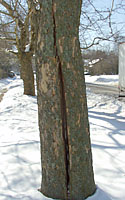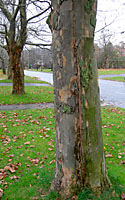Terry L. Ettinger Horticulture Consulting Services
Meeting The Needs Of Today With A Vision For The Future
Question of the Week
Frost Cracks
 Q. When I was out shoveling our sidewalk a couple of weeks ago, I was shocked to see a huge crack running up the
trunk of one of our sycamore trees. It starts just above the ground and must be at least ten feet long. It's also four
inches wide and at least six inches deep! I've never seen this before and would hate to lose the tree as it provides
much-needed shade during the summer.
Q. When I was out shoveling our sidewalk a couple of weeks ago, I was shocked to see a huge crack running up the
trunk of one of our sycamore trees. It starts just above the ground and must be at least ten feet long. It's also four
inches wide and at least six inches deep! I've never seen this before and would hate to lose the tree as it provides
much-needed shade during the summer.
A. You've described a "frost" crack. They're actually relatively common in sycamore, London plane (a hybrid between our native sycamore and oriental planetree), maple, linden, crabapple, and other smooth-barked trees.
 Frost cracks occur during bitterly cold, sunny winter weather that causes uneven heating and cooling of tree bark, the
cambial layer of live cells just beneath the bark, and interior wood. It's commonly held that during a sunny, cold winter
day, the wood of a tree's trunk can become twenty or more degrees warmer than the surrounding air. However, when the sun's
rays are blocked by a thick cloud, a building or even a nearby tree, the wood cools rapidly, causing it to contract and
split or crack vertically.
Frost cracks occur during bitterly cold, sunny winter weather that causes uneven heating and cooling of tree bark, the
cambial layer of live cells just beneath the bark, and interior wood. It's commonly held that during a sunny, cold winter
day, the wood of a tree's trunk can become twenty or more degrees warmer than the surrounding air. However, when the sun's
rays are blocked by a thick cloud, a building or even a nearby tree, the wood cools rapidly, causing it to contract and
split or crack vertically.
In planetrees, it's been observed that these cracks will open when air temperatures drop to 8º F, and continue to open wider as the temperature drops even more. It could be that this crack occurred just a couple of weeks ago during the stretch of bitterly cold, but relatively sunny weather we experienced between the middle and end of January. It's just as likely, however, that the crack occurred several years ago and you only noticed it this year when it opened during the cold weather?
Regardless of when it happened, the good news is that as the weather warms during the coming months, the crack will gradually close (photo above, at left). In fact, during the middle of the summer it may be almost invisible except for a raised ridge, or "rib" of callus tissue that will form over the edges of the wound. And, while it's possible for decay organisms to invade the crack, it's also possible that the tree will gradually seal it off and live for decades, even if it does open during future stretches of cold winter weather.